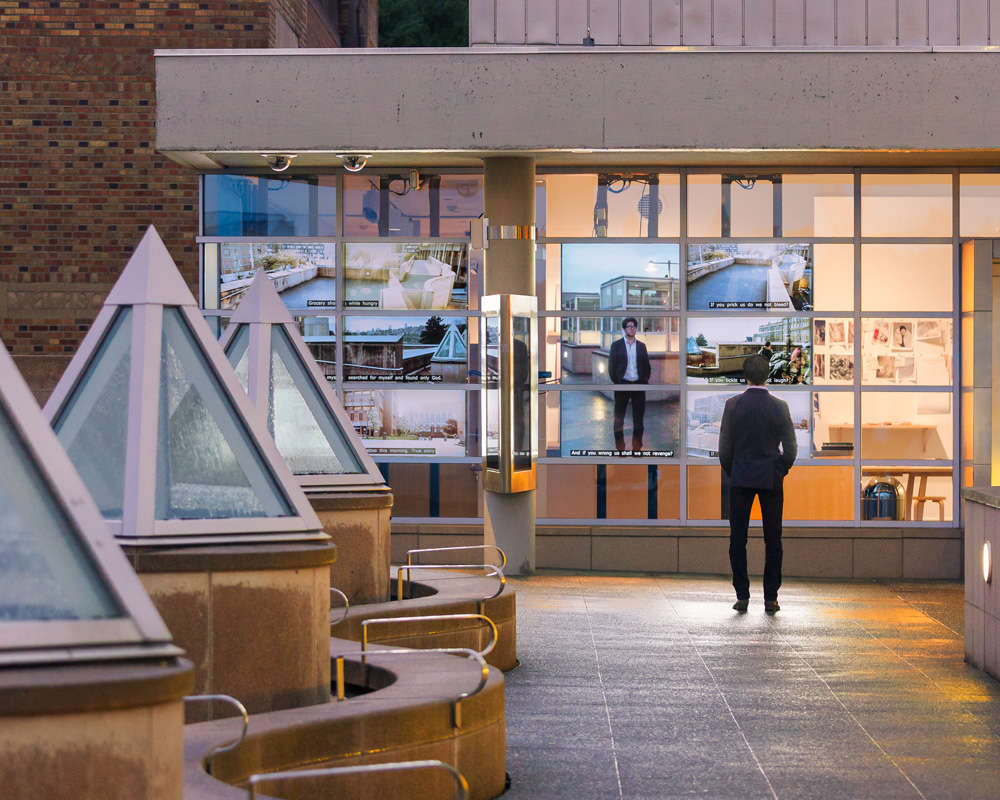Sanctum
Sanctum is a public artwork by James Coupe and Juan Pampin. I've been working on the systems underpinning this piece for the past 4 and a half years in one form or another. It's installed on the facade of the Henry Art Gallery from May 4, 2013 through November 5, 2015. It's an extension of the surveillance cinema platform James Coupe and I developed over the course of my tenure working at DXARTS. I plan to write extensively about this piece in the future. It's fantastically complex, both in an artistic and technical sense.

Sanctum is comprised of 4 distinct componets:
Surveillance Cameras
Sanctum uses a network of six smart surveillance cameras installed in and around the facade of the Henry Art Gallery. As a person approaches the gallery, they are tracked, and recorded by the cameras. The footage is analyzed in real-time by state-of-the-art computer vision and machine learning algorithms to determine each viewer's age and sex. The footage is tagged, registered in the system, and distributed to the video walls.
Narrative Engine
The stories used in the Sanctum project are generated from Facebook status posts volunteered by project participants. If you'd like to participate, please sign up! The engine is continuously downloading status posts from Facebook. Status posts are grouped by demographics, then stitched together to form new narratives. These narratives are then injected in the audio system for sonification, and used on the video walls as subtitles.
Video Walls
Three video walls grace the facade of the Henry. Two of the screens are on the South wall near the entrance. The other screen is around the corner on the West wall. The technology driving these displays was wholly written in-house, and deserves a post of its own. It was written to support real-time composition with high definition video.
Ultrasonic Speakers
The speakers driving the audio portion of the installation are ultrasonic, but you can hear them. They use phased arrays of transducers to demodulate the sound in the air into the audible frequency spectrum. Why? Because the difference between regular sound and ultrasound is similar to the difference between a light bulb and a laser. Ultrasound doesn't really spread, it stays in a very tight beam about the size of the array of speakers. If your head isn't in the path of the beam of sound, you won't hear it. Furthermore, by introducing delays in the columns of transducers you can steer the beam without moving the speaker cabinet. Couple this with some computer vision head-tracking and you've got an audio system capable of delivering a personalized audio experience from a distance.
The Interaction
As a person approaches the gallery, they hear a cacophony of voices, all telling stories. As they get closer to the gallery, the voices become clearer, gradually becoming a single voice that matches their age and gender, and telling a story composed from demographically-appropriate Facebook status updates. A grid of 18 large video monitors on the façade of the gallery picks their face out of the crowd, automatically integrating footage of them with a variety of live and pre-recorded footage from around the gallery façade.
The installation aims to create a locus of complex and intense social networking activity, reaching out of the gallery to embed the passer by. As unexpected flâneurs, people passing by the Henry are assaulted by a multitude of voices, videos and text, of which, as they approach the façade, they will eventually become the focal point.
Join the Sanctum Facebook application. By joining, your Facebook status updates will become content for Sanctum’s narrative system. All posts that you make to Facebook will remain anonymous – they will be tagged with age and gender, but no other personal data will be used. If you visit Sanctum at the Henry Art Gallery, you can potentially see your status updates used as parts of the stories that are generated.